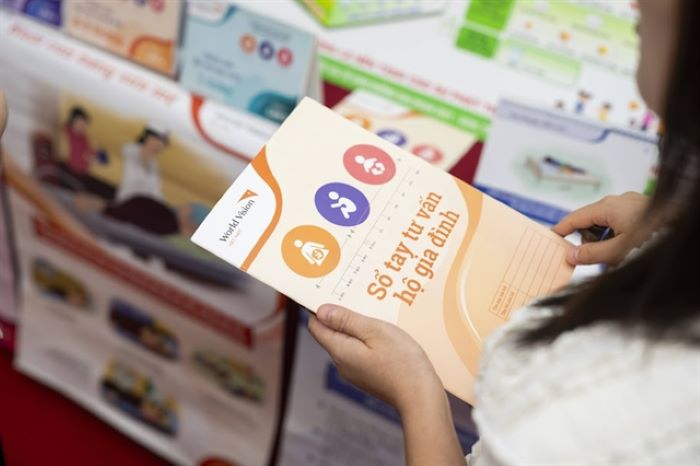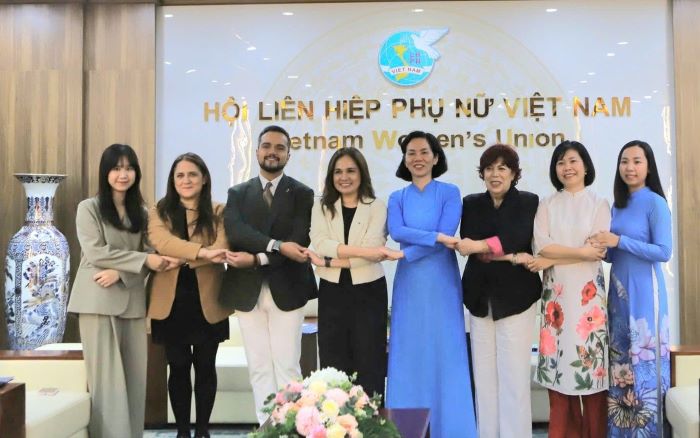Beginning of love: raising awareness of breastfeeding benefits
 Vi Thị Vinh (second right), her husband and her mother-in-law listen to guidance on infant care from community health volunteer Hà Thị Huyền
Vi Thị Vinh (second right), her husband and her mother-in-law listen to guidance on infant care from community health volunteer Hà Thị Huyền THANH HÓA — Vi Thị Vinh is happy to be breastfeeding her three-month-old baby.
The 30-year-old woman from the central province of Thanh Hóa is the mother of three children. The three-month-old boy is her third child.
Her baby boy is growing and developing normally.
Vinh’s family has received support from the community health centre since she became pregnant, and the mother also participates in a health and nutrition club.
“Since my family and I received support from the community health centre, I have experienced many positive changes and have overcome barriers in taking care of my children’s health and nutrition,” Vinh said.
During her pregnancy, her husband accompanied her to regular prenatal check-ups, where she was given advice on proper nutrition. She took iron supplements and vaccinations, and rested appropriately.
Thanks to this prenatal care, the foetus developed well, and the baby is now exclusively breastfed.
Home counselling

A book to take notes and monitor the health of both mother and baby — Photo courtesy of the World Vision International in Việt Nam
Vinh is one of the beneficiaries of the Timed and Targeted Counselling (TTC) model developed by World Vision International.
The model is designed for community volunteers and health workers and focuses on health care for mothers, newborns and young children.
It also promotes beneficial practices for health at different levels for individuals and families through family counselling activities.
Aligned with the World Vision International in Việt Nam's goals, the model aims to strengthen health programmes through a set of high-impact interventions to improve child welfare. The package includes seven interventions during pregnancy and 11 interventions for children under two years old.
Under the programme, a total of 30,104 pregnant women and caregivers of children aged 0-24 months have received counselling on nutrition and prevention of infectious diseases from 2018 to 2024.
Target groups for home visits include pregnant women, mothers of children under two years old, women aged 15–49, girls married under 18 years old, couples planning to have children, girls aged 12–15 and families with children under two years old, especially children classified as vulnerable.
Home counsellors are community health workers and volunteers.
Hà Thị Huyền, a community health volunteer, has been giving advice to Vinh. Home counsellors promote beneficial practices and advise families on improving health outcomes and baby care.
In the early pregnancy stage, from conception to around six months, Huyền makes at least two visits for prenatal care.
She also visits at least twice in the late pregnancy stage during the last three months to prepare the family for birth.
One week after the birth, during the early newborn care stage, Huyền visits at least once to help guide care for both mother and newborn.
During the infant care stage, from one week to six months, she makes at least two visits and gives breastfeeding support.
And in the toddler care stage from six to 24 months, the counsellor conducts at least four visits to promote proper complementary feeding, illness prevention and hygiene practices.
“With the TTC model and breastfeeding practice, malnutrition was reduced significantly,” said Huyền.
Breastfeeding

Experts express their commitment to create a sustainable breastfeeding support system. — VNS Photo Thu Trang
According to data from the 2019-2020 National Nutrition Survey, in Việt Nam the rate of exclusive breastfeeding in the first six months of a child's life remains low, at only about 45 per cent. Studies have shown that countries that boost this rate to above 70 per cent will significantly reduce the burden of disease and medical costs.
Thanh Hóa is one of the country's most populous provinces, with complex terrain and many ethnic groups. The provincial Department of Health plays an important role in implementing breastfeeding programmes.
Đỗ Thái Hòa, deputy director of the Thanh Hóa Department of Health, said: "For breastfeeding to become a cultural norm, it must be the shared responsibility of the whole community – including mothers, fathers, the health sector, education, media, businesses and the political system.”
In implementing directions from the Government and professional guidance from the Ministry of Health, the province has issued many intervention strategies to improve nutrition for children, with the goal of reducing the rate of malnutrition.
Malnutrition can present in a variety of ways, most notably in three forms: underweight children, stunted growth or acute malnutrition, sometimes called 'wasting'.
National Director of World Vision International in Việt Nam Doseba Tua Sinay said: “At World Vision, we focus on the first 1,000 days to improve child and maternal health.”
Key interventions include growth monitoring and counselling, with regular check-ups, which have helped more than 4,325 underweight children overcome malnutrition. Other main interventions involve home visits, in which trained volunteers reach thousands of mothers with advice on breastfeeding and child care, and village health worker support, which help hundreds of local workers provide antenatal care and promote exclusive breastfeeding.
“Each action sends a clear message: you are not alone. You are seen, supported and loved,” Sinay said.
In the past five years, World Vision International in Việt Nam has seen clear progress in child health and nutrition.
Community-wide engagement has strengthened awareness and collective responsibility for children’s health, contributing to a decrease in stunting (from 31.3 per cent to 24.3 per cent) and rates of underweight children (from 19.9 per cent to 14 per cent) over the five-year period.
“This is in line with our goal of improving the well-being of eight million children between 2023 and 2027, as we continue to scale up community nutrition models that are inclusive, sustainable and locally-led,” he said.
Nguyễn Văn Chi, deputy director of the Maternal and Child Health Department under the Ministry of Health, said that support for mothers during pregnancy and after birth, especially in remote, mountainous and ethnic community areas, was still limited.
He expressed the hope that medical staff would further promote their consulting and companionship roles to create trust for mothers.
“In Việt Nam, with the close direction of the Government and the Ministry of Health, along with the support of international organisations, the National Target Programmes and the First 1,000 Days of Life Nutrition Programme have contributed to significantly improving awareness of the benefits of breastfeeding in the community,” said Chi.
“Let's work together to build a solid support system so that every mother can give her child the best start in life with her own milk,” he added. — VNS







